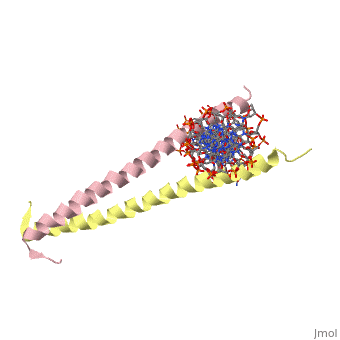Michael Pikaart/Biochem StructureIntro
 Chem311 Course Page 1 Introduction to protein structure
Chem311 Course Page 1 Introduction to protein structure
IntroductionIntroduction
A protein's function depends on the proper folding of the linear polymeric chain of amino acids making up its polypeptide sequence. Folding of a polypeptide occurs by way of rotation of the single bonds in either side of each amino acid residue's alpha carbon, characterized by the Φ and Ψ angles. In folded proteins, stretches of amino acids typically have a re-iterated and restricted set of Φ and Ψ angles, giving rise to a length of stable secondary structure. If this structure has a rotational displacement, the result is a helical secondary structure; if the structure occurs in a zig-zag arrangement, a sheet secondary structure results. Here we will explore these two types of secondary structures, as found in actual proteins.
Alpha helixAlpha helix
Helix or screw structures are found in lots of contexts, both in nature and in man-made objects like these:
Helices have a twist to them, either right handed or left handed. A normal right-tighty screw is a right-handed helix. We take a look at a protein called GCN4, a transcription factor found in yeast that binds DNA and regulates expression of genes responsible for synthesis of amino acids. (For more information, go to [1]). The GCN4 protein has a long section of alpha helix. Part of this helix binds directly to a particular sequence of DNA, while the part of the helix not in direct contact with the DNA binds to a second GCN4 molecule. In fact, GCN4 must bind to a second GCN4 molecule in order to bind DNA; GCN4 thus binds DNA as a homodimer. Thus the alpha helix of GCN4 provides both its DNA binding domain and its dimerization domain. We'll start with looking at the GCN4 dimer bound to DNA. It looks kind of like you're picking up a pencil between two fingers.
|
